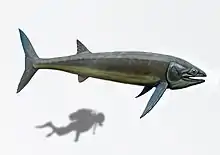Moreno Formation
The Moreno Formation is a Mesozoic geologic formation. Dinosaur remains diagnostic to the genus level are among the fossils that have been recovered from the formation.[1]
| Moreno Formation Stratigraphic range: Maastrichtian 70–66 Ma | |
|---|---|
| Type | Geological formation |
| Unit of | Chico Group |
| Underlies | Unconformity with the Martinez Formation and Tejon Formation |
| Overlies | Panoche Formation |
| Thickness | 1,600–2,000 ft (487.68–609.60 m) |
| Lithology | |
| Primary | Shale |
| Other | Sandstone |
| Location | |
| Region | |
| Country | |
Paleofauna
Color key
|
Notes Uncertain or tentative taxa are in small text; |
Ray-finned fish
| Ray-finned fishes reported from the Moreno Formation | ||||||
|---|---|---|---|---|---|---|
| Genus | Species | Location | Member | Material | Notes | Images |
|
B. gladius |
A large, filter-feeding pachycormid. |
| ||||
|
S. sp. |
An ichthyodectid. |
|||||
Dinosaurs
| Dinosaurs reported from the Moreno Formation | ||||||
|---|---|---|---|---|---|---|
| Genus | Species | Location | Member | Material | Notes | Images |
|
A. morrisi[4] |
||||||
|
S. morrisi[4] |
Reclassified as Augustynolophus morrisi.[4] |
|||||
Mosasaurs
| Mosasaurs reported from the Moreno Formation | ||||||
|---|---|---|---|---|---|---|
| Genus | Species | Location | Member | Material | Notes | Images |
|
K. bennisoni[5] |
The name Kolposaurus was preoccupied and its two constituent species moved to the new genus Plotosaurus.[5] |
|||||
|
K. tuckeri[5] |
||||||
|
P. crassidens[6] |
||||||
|
P. bennisoni[5] |
| |||||
|
P. tuckeri[5] |
||||||
|
P. cf. waiparaensis |
||||||
|
cf. Mosasaurus[7] |
cf. M. sp. |
|||||
|
H. sp. |
||||||
Plesiosaurs
| Plesiosaurs reported from the Moreno Formation | ||||||
|---|---|---|---|---|---|---|
| Genus | Species | Location | Member | Material | Notes | Images |
|
A. furlongi[8] |
||||||
|
F. drescheri[9] |
||||||
|
H. alexandrae[8] |
| |||||
|
M. stocki[9] |
||||||
Turtles
| Testudines reported from the Moreno Formation | ||||||
|---|---|---|---|---|---|---|
| Genus | Species | Location | Member | Material | Notes | Images |
|
J. Howard Hutchison later referred the specimen originally identified as Adocus by to the genus Basilemys.[10] |
||||||
See also
- List of dinosaur-bearing rock formations
Footnotes
- Weishampel, et al. (2004). "Dinosaur distribution." Pp. 517-607.
- Friedman, Matt; Shimada, Kenshu; Everhart, Michael J.; Irwin, Kelly J.; Grandstaff, Barbara S.; Stewart, J. D. (8 January 2013). "Geographic and stratigraphic distribution of the Late Cretaceous suspension-feeding bony fish Bonnerichthys gladius (Teleostei, Pachycormiformes)". Journal of Vertebrate Paleontology. 33 (1). doi:10.1080/02724634.2012.713059.
- Friedman, Matt; Shimada, Kenshu; Everhart, Michael J.; Irwin, Kelly J.; Grandstaff, Barbara S.; Stewart, J. D. (8 January 2013). "Geographic and stratigraphic distribution of the Late Cretaceous suspension-feeding bony fish Bonnerichthys gladius (Teleostei, Pachycormiformes)". Journal of Vertebrate Paleontology. 33 (1). doi:10.1080/02724634.2012.713059.
- Prieto-Márquez, Albert; Wagner, Jonathan R.; Bell, Phil R.; Chiappe, Luis M. (2014). "The late-surviving 'duck-billed' dinosaur Augustynolophus from the upper Maastrichtian of western North America and crest evolution in Saurolophini". Geological Magazine. 152: 225–241. doi:10.1017/S0016756814000284.
- "4: The Marine Reptiles; Mosasaurs," in Hilton (2003) p. 107-110
- "Appendix: Summary of the Mesozoic Reptilian Fossils of California," in Hilton (2003) p. 273
- Lindgren, Johan; Schulp, Anne (15 September 2010). "New material of Prognathodon (Squamata: Mosasauridae), and the mosasaur assemblage of the Maastrichtian of California, U.S.A." Journal of Vertebrate Paleontology. 30 (5). doi:10.1080/02724634.2010.501444.
- "Appendix: Summary of the Mesozoic Reptilian Fossils of California," in Hilton (2003) p. 276
- "Appendix: Summary of the Mesozoic Reptilian Fossils of California," in Hilton (2003) p. 277
- "4: The Marine Reptiles; Turtles," in Hilton (2003) p. 114
References
- Hilton, Richard P. 2003. Dinosaurs and Other Mesozoic Reptiles of California. Berkeley: University of California Press. 318 pp.
- Weishampel, David B.; Dodson, Peter; and Osmólska, Halszka (eds.): The Dinosauria, 2nd, Berkeley: University of California Press. 861 pp. ISBN 0-520-24209-2.
This article is issued from Wikipedia. The text is licensed under Creative Commons - Attribution - Sharealike. Additional terms may apply for the media files.


